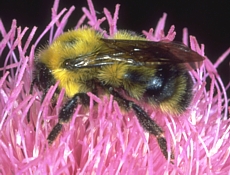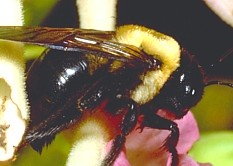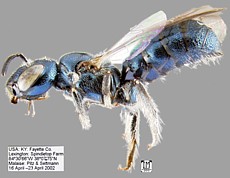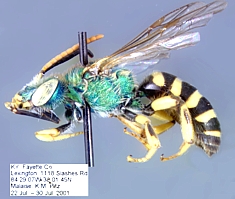|
|
ARTHROPODS:
Insects»
Spiders»
Centipedes»
Millipedes»
Sowbugs»
Harvestmen»
Mites
& Ticks»
Scorpions»
Identification
Tips»
About
the Critter Files»
Links» |
|
|
|
| |
| TAXONOMY |
KINGDOM:
Animalia | PHYLUM: Arthropoda | CLASS: Insecta | ORDER : Hymenoptera
SUPERFAMILY: Apoidea (bees) | FAMILIES: Apidae, Halictidae, others
|
| |
WHAT
ARE BEES?
LIFE CYCLE
ECOLOGY
PEST STATUS
COMMON KENTUCKY BEES
COLLECTING & PHOTOGRAPHY
BEE FACTS
MYTHS, LEGENDS, AND FOLKLORE |
| |
| WHAT
ARE BEES? |
|
| Bees
are special types of wasps that have evolved to visit flowers and
gather pollen and nectar. All bees are covered in branched hairs.
Wasps sometimes have hairs, also, but only bees have branched
hairs. These dense, branched hairs allow bees to carry pollen.
The branches cannot be seen without a microscope, though, so
it is sometimes difficult to tell the difference between bees and
other wasps. Some things to look for: bees are usually hairier
than wasps,and bees are often stouter in build than wasps. |
| |
|
| SIZE:
Adult body length up to 1" |
| |
| LIFE
CYCLE |
|
Like
all wasps, bees undergo complete metamorphosis with egg, larva,
pupa, and adult stages. Some bees, like honey bees and bumble
bees, live in social colonies. In these species, the bees
live and work together in hives to care for larvae, eggs, and pupae.
As with ants and hive-dwelling
wasps, honey bees and bumble bees have specialized members of
their hive, including workers, queens, and drones. Drones
are male bees, and their only function is to fertilize queens. All
worker bees are females, but only the queen bees mate and lay eggs.
Not all bees live in
hives, though. Some, like carpenter bees and halictid bees,
live a solitary lifestyle, much like solitary
wasps. Solitary bees usually build a small nest or burrow
for their eggs which they provision with pollen and nectar. When
the larvae hatch, they feed on the nectar and pollen until they
pupate. A few species of solitary bees are parasites of other
bees. These species lay their eggs inside the nests of other
bees, and their larvae eat the nectar and pollen intended for the
host larvae.
Most solitary bees spend
the winter as eggs or pupae. All the members of bumble bee
colonies die in the winter except for newly mated females who emerge
in spring to build new colonies. Honey bee colonies are able
to persist through the winter by eating stored honey. |
| ECOLOGY |
|
Bees are a very important
part of their ecosystem because they help flowering plants pollinate:
as bees move from flower to flower gathering pollen and nectar,
they transfer pollen from one flower to another. Without this
pollen transfer, many plants would not be able to produce seeds.
Many bees have stingers
which help them to defend themselves (and their hives, in the case
of honey bees and bumble bees) from predators. Despite this
defense, bees are often eaten by spiders, assassin bugs, birds,
and wasps. Crab spiders,
in particular, specialize in preying on bees and other pollinators.
Bee hives are sometimes torn apart by mammals like bears and
badgers who eat honey and larvae.
In addition, some parasitic
arthropods (including mites) are able to live inside bee hives.
Some of these parasites are able to disguise themselves so
that the hive bees do not detect the intrusion. Read our ENTFact
about Varoa
Mites for more information.
|
| |
| PEST
STATUS |
|
Because
bees are such important pollinators, and because they do not eat
plants, they are considered beneficial to humans. Honey bees
also provide honey and wax. However, honey bees and bumble
bees sometimes cause problems to humans because of their aggressive
defensive behavior, and many people have potentially lethal reactions
to bee stings. Read our ENTFact about Nuisance
Honey Bees for more information. A few solitary bees are
sometimes pests as well. Read our ENTFact about Carpenter
Bees that sometimes damage wooden structures when they build
their egg chambers.
|
| |
| COMMON
KENTUCKY BEES |
|
|
HONEY
BEES & BUMBLE BEES
FAMILY: Apidae
| GENUS & SPECIES: Apis mellifera (honey bee), Bombus
spp. (bumble bees)
Honey Bees
and Bumble Bees are the most commonly seen bees
in Kentucky. They are the only Kentucky bees that live in
social colonies. Honey bees usually build their hives in hollow
trees or in man-made structures. Bumble bees often find spaces
for their hives underground in abandoned mammal burrows. Bumble
bees are native to Kentucky, but honey bees were brought to the
United States for their honey and wax production. |
| |
 Honey
Bee (R. Bessin, 2000)
Honey
Bee (R. Bessin, 2000) |
 Bumble
Bee (R. Bessin, 2000)
Bumble
Bee (R. Bessin, 2000) |
|
|
|
CARPENTER
BEES
FAMILY:
Apidae | SUBFAMILY: Xylocopa
Kentucky has several species
of Carpenter Bees. The most common species
are in the genus Xylocopa, which resemble bumble bees, except
that these carpenter bees have a relatively smooth abdomen and bumble
bees have very hairy abdomens. Unlike bumble bees, carpenter
bees do not live in hives. Many species dig holes in dead wood
where they lay eggs and provision with nectar and pollen. Carpenter
bees are sometimes considered pests because they will dig holes in
wooden sheds, porches, and other structures. They rarely do
serious damage to these structures, though. Common carpenter
bees are about 1" long, but some species are smaller and have
black or metallic coloration, like the Ceratina sp. pictured
below right. |
| |
 Carpenter
Bee, Xylocopa sp. (R. Bessin, 2000)
Carpenter
Bee, Xylocopa sp. (R. Bessin, 2000) |
 Carpenter
Bee, Ceratina sp. (K. Seltmann, 2004)
Carpenter
Bee, Ceratina sp. (K. Seltmann, 2004) |
|
|
|
HALICTID
BEES
FAMILY: Halictidae
Halictid Bees
are small bees (1/4" - 1/2" long) in the family Halictidae.
Most halictid bees are shiny black, metallic green, or metallic
blue. Some halictid bees are called "sweat bees"
because they land on skin to gather sweat droplets. The bees
will sometimes sting while they are doing this, but only if they
are swatted or startled. Some bee-like hover
flies in the family Syrphidae are also sometimes called "sweat
bees," but they are not bees and do not sting or bite.
Most halictid bees are
solitary and create underground nests for their offspring. However,
halictid bees are especially interesting to biologists because many
species have evolved to live in social colonies recently in evolutionary
history. Closely related halictid bee species are known
to be social in one habitat and solitary in another. These
patterns can help biologists study the origins of social behavior
among insects. Some Kentucky halictid bee species show intermediate
social behavior: several individual bees create nests near one another
but do not work together.
The halictid bee shown
below right is part of the interactive key to the hymenoptera developed
by University of Kentucky researcher Katja Seltmann for the "Hymenoptera
- Assembling The Tree of Life" project. This project
is part of the ongoing effort among taxonomists to assemble an electronic
key to all organisms. |
| |
 Halictid
Bee (B. Newton, 2003)
Halictid
Bee (B. Newton, 2003) |
 Halictid
Bee (K. Seltamnn, 2004)
Halictid
Bee (K. Seltamnn, 2004) |
|
| |
| COLLECTING
& PHOTOGRAPHY |
|
Bees
are common and easy to find around homes, lawns, and gardens where
they visit flowers for nectar and pollen. Because of their
stings, great care must be taken when collecting a bee or trying
to get a picture. If you are allergic to wasp, ant, or bee
stings, you should never try to catch a bee: ask your doctor to
test whether or not you are allergic. Bees should never be
touched, and should be caught only in a net and transferred immediately
to a sturdy glass container. It is usually possible to get
a picture of a bee as it visits a flower.
|
| |
| BEE
FACTS |
|
Scientists believe
that flowers have co-evolved with bees and other pollinating insects.
In fact, it has been hypothesized that many of the world's
flowers would not exist if bees and other pollinators had not evolved.
The idea behind this hypothesis is easy to understand: the only
function that colorful, fragrant flowers serve is to attract pollinators.
So if pollinators did not exist, perhaps many flowers would
not either.
It is well-known that
honey bees have barbed stingers, and that they are only able to
sting once: when the sting goes into skin, the barb holds it inside,
and when the bee pulls away, the stinger is torn from its body.
This is only true for worker honey bees: queen bees do not
have barbed stingers, and neither do bumble bees or solitary bees.
A live, working bee hive
is a great thing to have in a classroom! Read our ENTFact
about Starting
an Observation Bee Hive.
|
| |
| MYTHS
- LEGENDS - FOLKLORE |
|
It is sometimes said
that honey bees and bumble bees will not sting at night. This
is not true! Although bees are less active at night, they will still
sting to defend their hives.
Mary Harris from Alabama
says that her father, Ernest Hyatt Harris, called carpenter bees
"steadybobs" because of their ability to hover and "bob"
in the air. Please let us know if you know other names for
these bees! |
|
Original document: 25 May 2004
Last updated: 25 March 2005
Photos courtesy R.
Bessin, K. Seltmann, and B. Newton, University of Kentucky
The Kentucky Critter Files are maintained by Blake Newton, Department
of Entomology, University of Kentucky.
Contact: blaken@uky.edu
|
|

